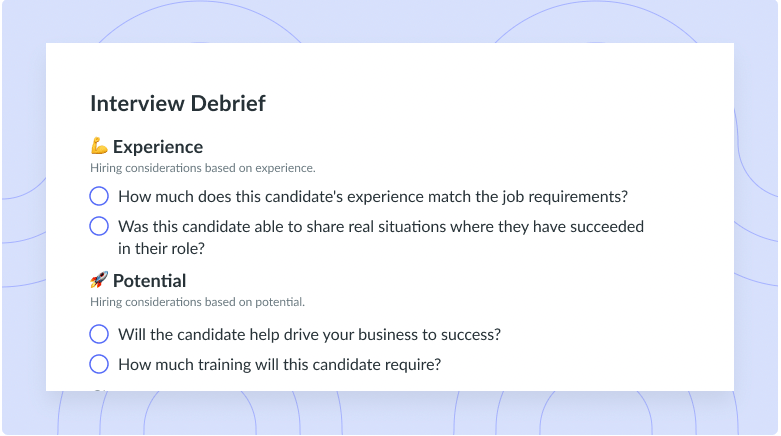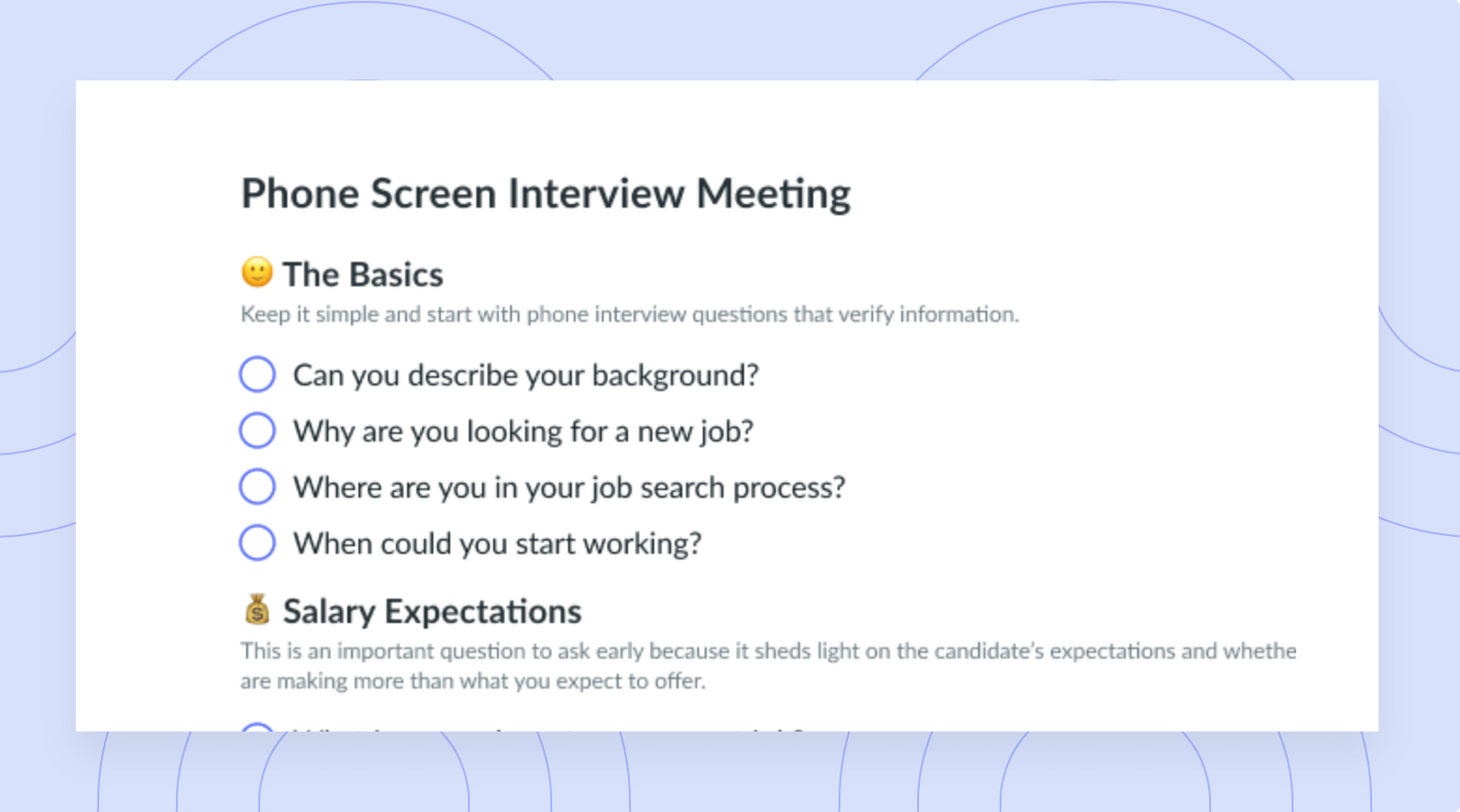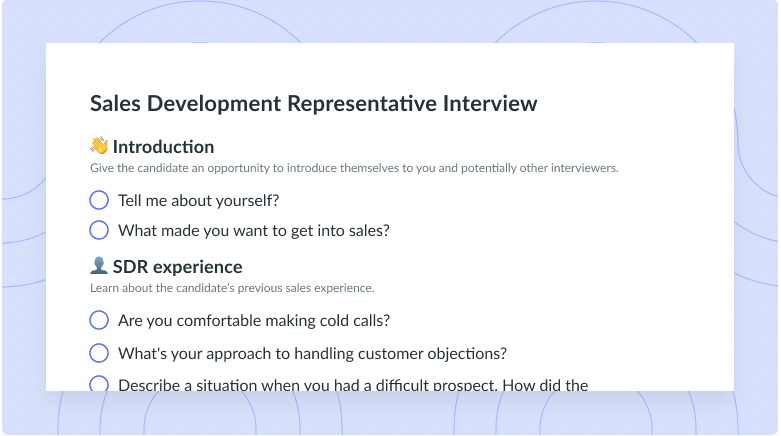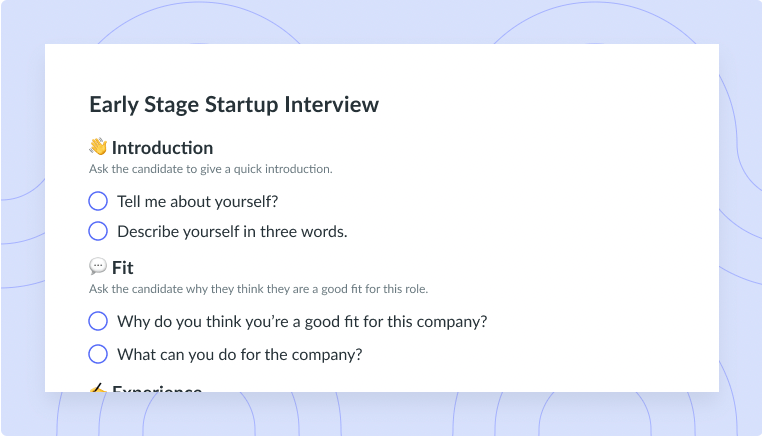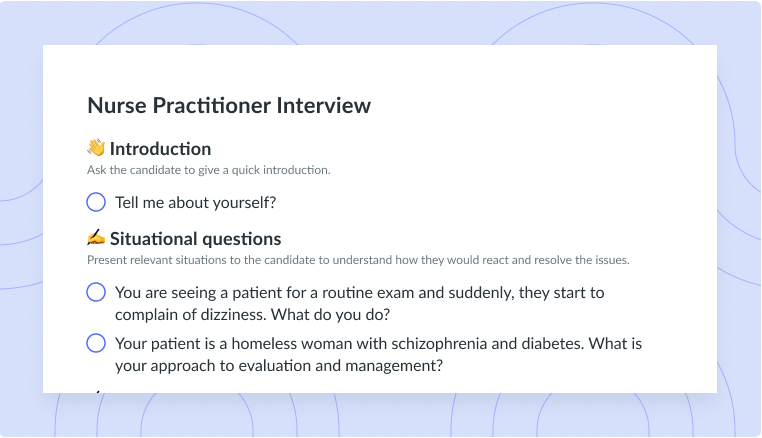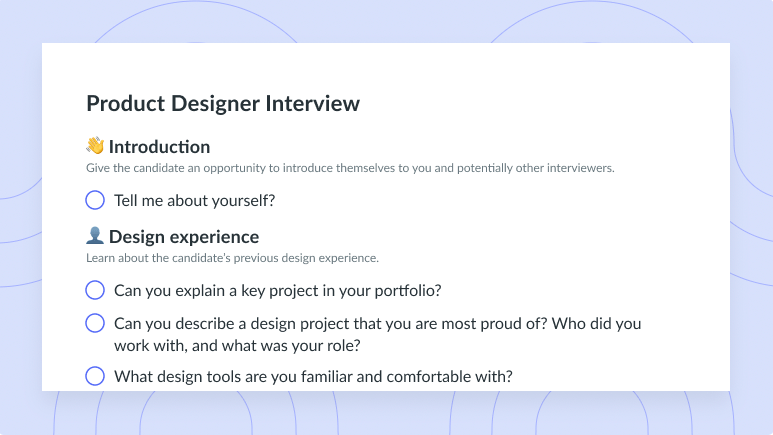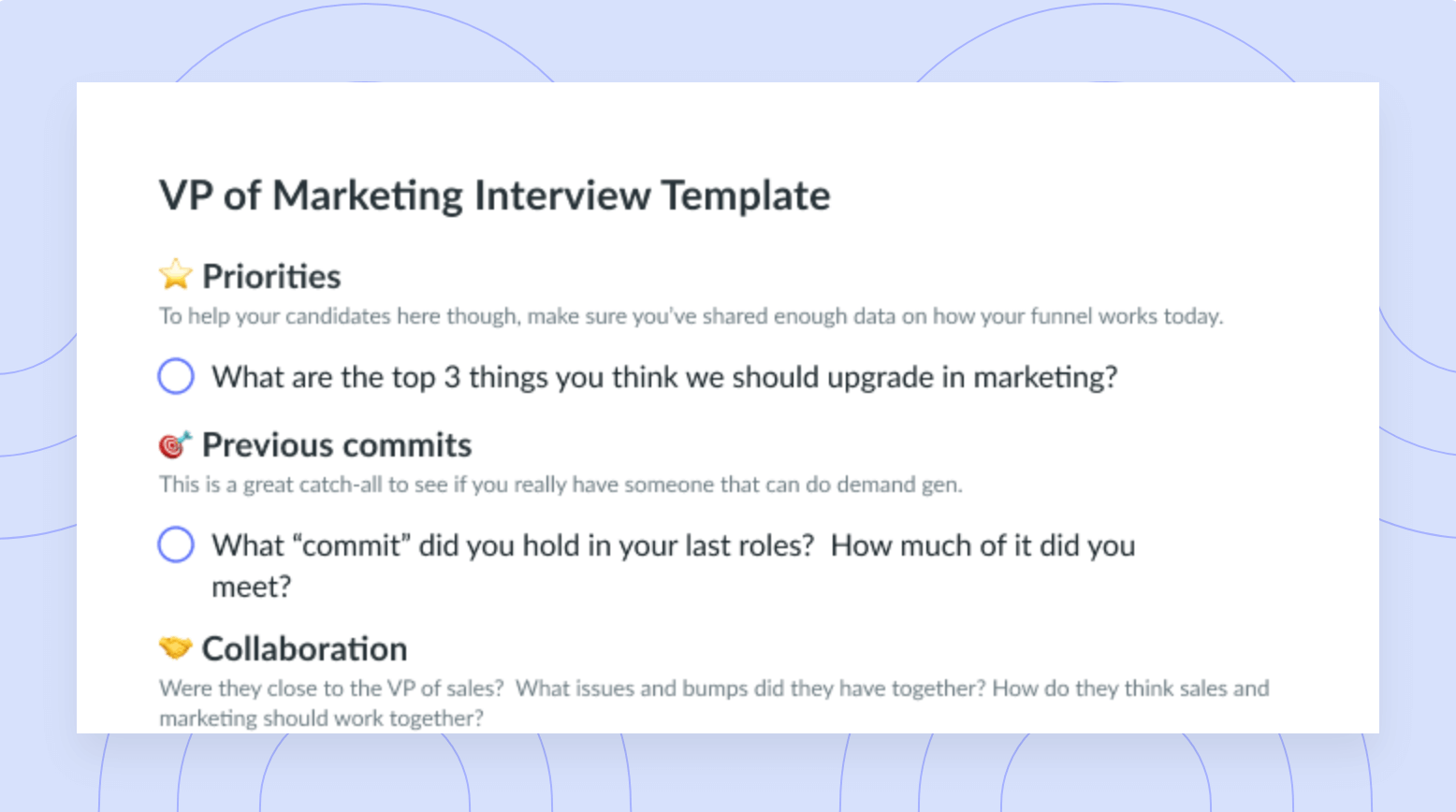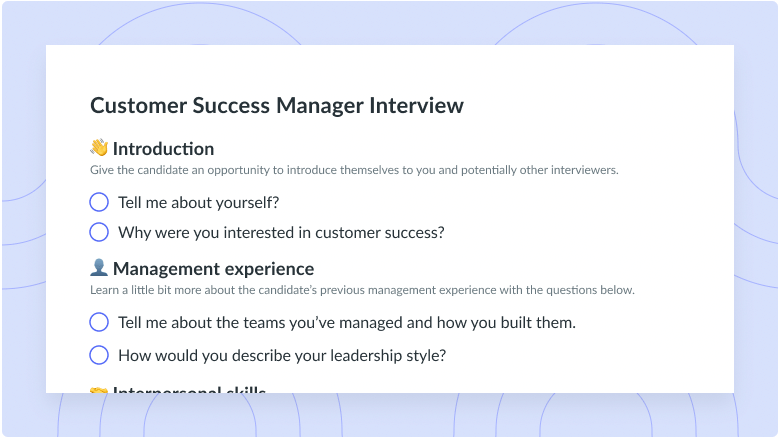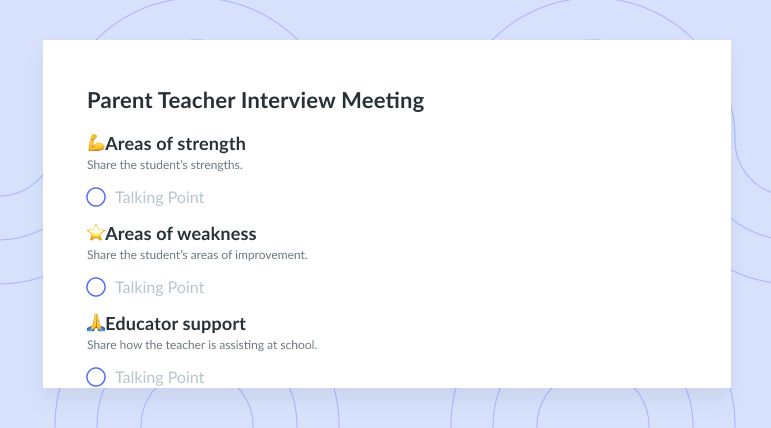How to Conduct a Job Interview Effectively in 12 Easy Steps
Job interviews can be stressful – for both you and your potential new hire. Here’s how to conduct a successful interview in 12 simple steps.
Conducting job interviews the right way can lead to hiring the right people. A great interview will give the candidate plenty of great info about your organization – and give you just as much info about the candidate. And although talking to someone new can be fun, it can also be anxiety-inducing for both parties. Read on to discover how to conduct a successful job interview in 12 steps.
12 steps to conducting a job interview
Here’s how you can conduct a job interview in 12 steps:
- Greet your candidates kindly
- Set the scene
- Go into detail about the job description
- Ask generalized questions at the beginning
- Go through your candidate’s resume
- Look out for STAR interview answers
- Create a plan for your questions
- Ask about real scenarios
- Save time for candidates to ask questions
- Determine if they’re a cultural fit
- Give them a timeline
- Convince your candidate
1Greet your candidates kindly
A friendly introduction to job candidates can put them at ease and make them feel more comfortable. Talk a bit about yourself and your organization at the start of each interview. You should also hold eye contact and keep your phone screen face-down to show that you’re paying attention. These small gestures can show that you respect the person you’re interviewing – and that can lead to a great first impression.

Everything in one place
Preparing an agenda with the interview questions and the candidate’s answers will help you reflect on the interview process and make a sound decision. Try a tool like Fellow!

2Set the scene
Before you dive right into the interview, tell your applicant what they should expect for the interview process. Some things you may want to discuss are how many interviews they should expect and how many different people they’ll meet for interviews. After all, your candidate has a choice to make too – should they stay the course with you or look for jobs elsewhere? Your goal is for them to stick with you.
That’s part of why your behavior can set the tone for the rest of your interview. You want to find a happy middle ground between casual and over-the-top professional. If you’re too casual, the person you’re interviewing might not take you seriously. But if you’re super professional, you might slightly intimidate your candidate. And that could be a problem for more than just you – how you act during the interview will reflect on your whole organization.
3Go into detail about the job description
While it’s likely that your candidate reviewed the job description before applying, you should go over it more in-depth during the interview. Describe what their day-to-day work might look like and the responsibilities they’ll have if they get the position. You also want to mention whether the position is temporary, part-time, full-time, or contract.
4Ask generalized questions at the beginning
Start your interview with a few general questions. These could be about anything from the candidate’s interest in the position to their background. Your goal is to get the candidate to explain why they’d be a good fit for your organization and what they’d contribute.
5Go through your candidate’s resume
When you look at your candidate’s resume, ask them questions about anything that relates to the position. For example, if you’re hiring for a bilingual teaching position, you can ask about any study abroad programs on their resume. You could also talk about previous internships or work experience.
It’s also important to ask your candidate their reason for leaving their previous job. This question will help you see whether the person you’re chatting with is reliable and dedicated instead of impulsive and easily dissatisfied.
6Look out for STAR interview answers
The STAR process is a certain way that job candidates might answer questions. It’s great for them – and for you if you notice it – because it paints a picture of a specific situation. STAR stands for:
- Situation. Explain your situation. How did you end up there? What was going on?
- Task: What were the requirements? What was the goal?
- Action. What action did you take to overcome the situation?
- Result. What was the outcome?
Some candidates use this method when the interviewer asks them about something they’ve done. For example, “Tell me about a time you made a mistake. How did you handle it?” Listen carefully to see if the candidate used STAR in their response. If they didn’t, you could use STAR to ask follow-up questions. If they did, you’re probably dealing with a pretty transparent potential hire, and that’s only a good thing.
7Create a plan for your questions
When you begin the hiring process, you should create a list of the types of questions you want to ask all your applicants. Your questions should relate to the position’s responsibilities. This can help you figure out your candidates’ strengths and weaknesses to find the best match. You also want to ask open-ended questions during the interviews. These questions give your applicant the opportunity to share as much detail as they’d like rather than simply saying “yes” or “no.”
8Ask about real scenarios
In your interview, you should ask your candidate about real scenarios that might come up on the job. Start by explaining an issue, then ask your candidate to walk you through how they’d solve it. For example, say you work at a magazine. One question may be, “You took your magazine to print the day before the release party, and then you discovered an entire section was missing. What would you do?” This can help you see their thought process and make better hiring choices.
9Save time for candidates to ask questions
Candidates should also have the opportunity to ask you questions. Their questions can also tell you how well they prepared for the meeting, and if they’re actually interested. Ideally, in a job interview, you’ll follow the 80/20 rule: Talk 20 percent of the time and listen during the other 80 percent.
10Determine if they’re a cultural fit
A lot of successful hiring comes from the idea of a “cultural fit.” How comfortable would your candidate feel at your organization? How comfortable will your team feel with this new person? Does this person work better in a team environment or by themselves? Do they think long-term or short-term or both? Think about your organization’s work environment, then compare it to your candidate and how they work.
11Give them a timeline
Toward the end of your interview, after you’ve answered your candidate’s questions, give them a timeline. Let them know approximately when they’ll hear from you and what the next steps will be. Give them an idea of when they can follow up if they don’t hear from you first.
12Convince your candidate
If you think you’ve found the perfect candidate to fill the role, now’s the time to wow them. First, let them know that you think they might be an excellent fit. Then, ask them if they’d like to see the office or if they want to meet anyone in the organization. Remember, interviews are two-way streets – you need to sell them as much as they need to sell you.
How to prepare for the interview
Here’s how you can set yourself up for success for each interview:
- Schedule an appropriate amount of time
- Go over the candidate’s resume again
- Review your job description
- Identify your intangibles
- Write down questions
- Lower their stress and make them comfortable
1Schedule an appropriate amount of time
When you schedule your job interview, make sure you set aside enough time so it doesn’t feel rushed. Ideally, you should schedule 30 minutes to an hour for your interview. You should also find a good location to host your interview. To ensure that your phone or team members won’t interrupt you, choose a quiet location. Sometimes, unexpected technology issues or life situations can interrupt an interview. Consider using text messaging for recruiting for faster communication in the case of an unexpected situation.
2Go over the candidate’s resume again
You should look over the candidate’s resume a few times before their interview. You should also have an extra copy of their resume at the interview in case you need to refer back to it. The interview isn’t a time to ask bland questions such as “What have you done before this?” That answer is already on their resume. Instead, you want to use this time to dig deeper and really get to know the person in front of you.
3Review your job description
Before your interview, you should review the job description posted online to remember what you’re looking for from your new hire. Refreshing yourself on the position can make it easier for you to compare all your candidates. Also, if something in the description drew the candidate to the job, you can use that to come up with questions.
4Identify your intangibles
While a candidate’s resume and cover letter are excellent for telling you about their experience, they can’t tell you everything. For example, what personality traits or behaviors are you looking for? You may want to write a list of these things ahead of time so you know what to ask later.
5Write down questions
One common hiring mistake is entirely winging the interview. Instead, you want to have at least 10 questions that you can consistently ask each candidate. Asking everyone similar questions will make it easier for you to compare the candidates you’ve interviewed to find the right one. That said, it’s still important to go off-script a bit and cater each interview to each applicant.
6Lower their stress and make them comfortable
Interviews can be stressful and overwhelming. That’s why one of the best things you can do at an interview is build a comfortable, relaxed environment. At the beginning of the interview, talk about yourself a bit to help your candidate release any pre-interview jitters. Remember, you were once in their shoes. Try taking approaches that helped you feel more confident when you were in their position.
Get feedback on your interviewing process with Fellow
Interviewing isn’t stressful for just candidates – it can also bring on anxiety for interviewers. After all, how are you supposed to know how well you interview people unless you get their feedback? With Fellow, you can receive anonymous feedback from new hires and organize your ideas during the onboarding process. It’s a huge help for interviewing and hiring, all under one streamlined platform.







![How to Have an Effective Reverse Interview [+Examples]](https://fellow.app/wp-content/uploads/2022/07/reverse-interview.jpg)

